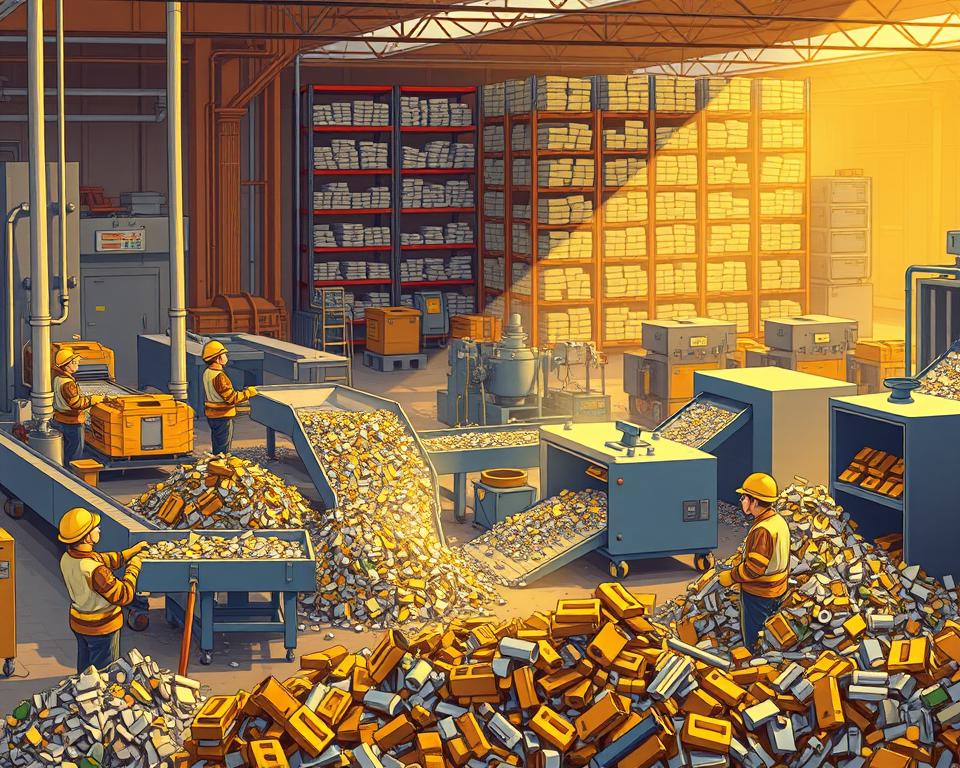Eco-Friendly Guide to Precious Metal Recycling
Were you aware that electronic waste throws away over $60 billion of precious metals annually? This staggering figure underlines the critical role of precious metal recycling. It’s not just good for our economy but also for the environment. Reclaiming gold, silver, platinum, and palladium helps lower pollution and preserve what’s left of our natural resources.
Firms like Dongsheng Metal Trading spearhead the movement toward greener recycling. They guarantee that valuable metals return to use instead of filling dumps. That precious metals recycling strategy underpins green recycling and long-term sustainability.
Highlight Reel
- More than $60 billion of precious metals end up in e-waste each year.
- Recovering these metals cuts eco-impact and preserves resources.
- Valuable metals include gold, silver, platinum, and palladium.
- Sustainable development depends on eco-friendly recycling.
- Companies like Dongsheng Metal Trading specialize in metal recycling.
Understanding Precious Metals and Their Value
Rare metallic elements known as precious metals attract both investors and manufacturers. Gold, silver, platinum, and palladium stand out for their distinct qualities. Notable traits are excellent conductivity, corrosion resistance, and rarity. The extraction and processing of these metals require considerable resources, underscoring the importance of recycling precious metals.

Market demand and each metal’s properties drive its value. Recovering metals is key to keeping the supply chain alive. It cuts the environmental toll of mining operations. Through exhaustive recycling processes, these metals can be restored to their original state. That process conserves scarce materials and boosts the economy.
Precious Metals Explained
These metals’ special traits lend themselves to diverse applications. Scarcity plus special properties drive their economic importance. For example:
- Au: Admired for its luster and low corrosion.
- Ag: Known for flexible uses and excellent conductivity.
- Platinum: Esteemed for its toughness and catalyst role.
- Pd: Gaining traction in cars and electronics.
Why Recycle Precious Metals?
Recycling these metals is now key to sustainable practices. It helps conserve these finite resources and significantly reduces the ecological footprint tied to traditional mining. Key benefits include:
- Reduction of environmental degradation caused by mining operations.
- Lower energy consumption compared to extracting new metals from the earth.
- Supporting a circular economy via material reuse.
- Opportunity for profit by recovering valuable metals.
Why Precious Metal Recycling Matters
Metal recycling brings both green and economic gains. Highlighting these advantages is key to reducing our ecological footprint. Additionally, it fuels market growth and resilience.
Green Benefits
The environmental benefits of recycling precious metals are significant. Retrieving metals from scrap and electronics reduces landfill load. This reduces the need for new mining, conserving natural resources.
This approach minimizes the harmful effects of mining, such as habitat destruction and pollution. Focusing on recycling precious metals helps us strive for a more sustainable future.
Economic Benefits
Financial perks of recycling are just as strong. Recovering metals cuts production expenses. It lets businesses choose reclaimed over freshly mined metals.
This shift creates jobs in recycling facilities and boosts market stability as demand for recycled metals grows. Using these financial benefits, companies can improve profits. They add to a more sustainable marketplace.
How Precious Metals are Recycled
The precious metal recycling process is complex, involving several stages to ensure maximum efficiency. It starts with collecting metals from various sources like discarded electronics, jewelry, and industrial scraps. Next comes sorting, cleaning, and testing to assess metal content and worth.
Recycling Workflow
Such a methodical process ensures efficient recovery. Each step is designed to optimize the yield of precious metals. Sorting divides metals by kind and grade. Decontamination eliminates residues that block recovery. Chemical analysis pinpoints metal levels to drive technique decisions.
Recovery Methods
High-tech methods are used to maximize metal retrieval. Thermal reduction applies intense heat to isolate metals. Molten refining and wet-chemistry steps handle finer separations. Recyclers like Dongsheng Metal Trading employ these approaches to improve yields and returns.
Which Precious Metals Are Recyclable
Scrap recovery benefits both Earth and economy. A host of precious metals are recyclable, aiding markets and ecosystems. Awareness of recyclable metals guides consumers and companies.
Gold, Silver, and Platinum
Familiar precious metals include gold, silver, and platinum. They’re found in jewelry, coins, and industrial uses. Gold’s high price and use make it a prime recycling target. Silver recovery matters too, thanks to its role in imaging, tech, and solar.
Though scarcer, platinum’s worth shines in auto catalysts.
Electronics Precious Metals
E-waste metals present special recovery opportunities. Devices such as phones and computers hold palladium and indium. These metals are a treasure trove for recycling, reducing e-waste and providing essential materials.
The need to recycle these metals is critical. Businesses work to reduce scrap and upscale resource recovery.
Industries that Benefit from Precious Metal Recycling
Precious metal recycling is essential for several key industries, allowing them to use valuable resources efficiently and sustainably. Electronics, which embeds metals in gadgets, gains the most. The aerospace and medical fields use precious metals in essential applications. Examining industry recovery uncovers eco- and economic advantages.
Tech Electronics
The electronics industry leads in precious metal recycling due to the abundance of valuable metals in devices like smartphones and computers. Quick device turnover spawns more electronic scrap. This makes effective recycling of these metals, such as gold, silver, and palladium, critical. That saves resources and cuts mining carbon footprints.
Businesses enhance recovery to align with green and zero-waste aims. This shift supports the ongoing need for resource conservation and environmental protection.
Aerospace & Medical
Recycling precious metals matters for aerospace and healthcare, given their reliance on them. Alloys prized for strength and anti-corrosion make up flight and medical components. Recovering them cuts costs and meets green regulations.
They recognize that recycling offsets material scarcity. It also enhances operational efficiency, making recycling a key strategy for sustainability.
How to Choose a Metal Recycler
Locating reliable recycling partners ensures great results. You should probe their procedures thoroughly. Knowing their pricing and processing methods can greatly affect your experience. Reviewing offerings lets you select wisely.
Key Questions for Recyclers
- What certifications do you hold regarding precious metal recovery?
- Can you explain your processing methods for different metals?
- What are your recovery rates for various precious metals?
- Can you detail your fees and any surcharges?
- Can you provide references or testimonials from previous clients?
Comparing Prices and Services
When searching for a recycler, it’s vital to compare different companies based on their services. Use a table to line up these factors:
| Company Name | Recovery Rate (%) | Processing Fee ($) | Turnaround Time (Days) |
|---|---|---|---|
| Recycling Co. A | 95 | 50 | 7 |
| Recycling Co. B | 90 | 45 | 5 |
| Recycling Co. C | 92 | 55 | 10 |
Side-by-side comparisons help pinpoint the ideal recycler. It guarantees maximum value and compliance.
Recycling Precious Metals: A Green Guide
Knowing recycler operations matters if you recycle metals. They oversee everything from scrap pickup to refining. This ensures maximum efficiency and value from metals.
Behind the Scenes of Recycling
Recyclers use advanced methods for metal recycling, including testing, separation, and refining. First, they gather scrap from multiple origins. Afterwards, they apply refined techniques to isolate each metal. Finally, they refine each batch to recover gold, silver, platinum, etc.
This process not only maximizes resource recovery but also supports eco-friendly practices. It’s essential for long-term sustainability.
Finding Your Perfect Recycling Partner
When picking a recycler, several factors are important. Begin by checking their green credentials. Now more than ever, green commitment is crucial. Also, examine if they handle everything or only certain stages.
Cost is equally important. Request estimates from multiple firms. Companies like Dongsheng Metal Trading offer customized solutions for various industries. They are a reliable choice for specific recycling needs.
The Role of Metal Recycling Facilities
Metal recycling is a critical sector for sustainable practices and waste management. Multiple types of facilities handle various recycling demands. Awareness of facility types guides you to proper recyclers. It aids companies and conserves nature.
Facility Categories
Metal recycling facilities vary widely in their operations. Some focus on precious metals, while others handle a wide range of materials. Here are a few common types:
- General scrap yards handle both ferrous and non-ferrous materials.
- Precious Metal Recovery Companies: With a focus on high-value materials such as gold, silver, and platinum, these companies offer refined processing techniques.
- E-waste hubs target valuable metals inside tech devices.
Choosing Facility Locations
Easy access to facilities boosts recovery efficiency. Firms need to plan transport logistics. Key access factors include:
| Factor | Description |
|---|---|
| Distance | Facilities located nearer to businesses minimize transportation costs and time. |
| Networking | Having established relationships with local recyclers can enhance efficiency in recycling processes. |
| Service Range | Awareness of service menus aids in picking the right center. |
In sum, selecting the right type of recycling center and ensuring convenient access can significantly enhance the efficiency of metal recycling operations.
E-Waste Recycling & Metal Recovery
E-waste poses a major ecological challenge. Old gadgets hide valuable metals ripe for recovery. That underscores viewing e-waste as a metal source.
How Electronics Contain Precious Metals
Many electronic devices hold small amounts of precious metals like gold, silver, and palladium. These metals are found in various parts:
- Circuit boards
- Connectors and ports
- Capacitors and resistors
- Battery terminals
Even everyday items like smartphones, laptops, and TVs are filled with these metals. Recycling lets us reclaim and repurpose those metals.
Why Recycle E-Waste?
Recycling electronics protects nature and recovers resources. That cuts landfill volume and conserves resources. Key perks include:
- It minimizes environmental risks from improper disposal
- It cuts down on carbon emissions through eco-friendly practices
- It fuels a circular economy by feeding materials back into manufacturing
Promoting e-waste recovery advances resource stewardship. It secures a healthier planet for tomorrow’s children.
What’s Next in Metal Recycling?
The field of precious metal recycling is undergoing a transformation, driven by technological progress and a surge in sustainability efforts. As the need to conserve resources grows, major players in recycling are adapting. Adopting fresh techniques, they’re shaping tomorrow’s recycling.
Eco-Friendly Recycling Innovations
Current trends in sustainable recycling focus on reducing waste and minimizing environmental impact. Businesses adopt green packaging and energy-saving techniques. These changes align with global sustainability objectives, pushing industries towards more responsible and planet-friendly behaviors.
New Metal Recovery Tech
New methods in recovery enhance recycling performance. Robotic sorting and chemical extraction raise recovery. They ramp up yields and shrink eco-footprints, advancing metal recycling.
Starting a Precious Metal Recycling Venture
Building a metal recycling enterprise calls for thorough planning and industry knowledge. Leaders should map out steps, secure compliance, and set firm roots. Key tasks include market studies and pinpointing customer segments. Permits and regulatory clarity underpin ongoing success.
Steps to Establishing a Business
Setting up a precious metal recycling venture requires several essential steps:
- Research the market to grasp demand and competition.
- Develop a detailed business plan outlining goals and strategies.
- Invest in equipment tailored to your process needs.
- Raise startup funds through financing or investors.
- Obtain vital permits and licenses for legal operation.
- Implement a marketing strategy to draw in customers.
Legal Considerations and Certifications
Knowing regulatory requirements is vital for a recycling startup. Complying with eco-regulations keeps your business green and lawful. Must-know compliance points:
- Securing business certification from relevant authorities.
- Following all levels of waste and recycling regulations.
- Ensuring all employees are trained on safety protocols and procedures.
Conclusion
Recovering precious metals conserves resources and protects our planet. It helps people and companies cut waste’s ecological toll. That reclaimed metal cuts mining demand and spawns recycling jobs.
Beyond green gains, recycling yields financial perks. Partnering with companies like Dongsheng Metal Trading ensures a commitment to eco-friendly practices. Such alliances reinforce the circular economy for all stakeholders.
The journey to a sustainable future depends on collective action in recycling precious metals. Raising awareness fosters mindful use and eco stewardship. Embracing these steps helps today and protects tomorrow’s world.

